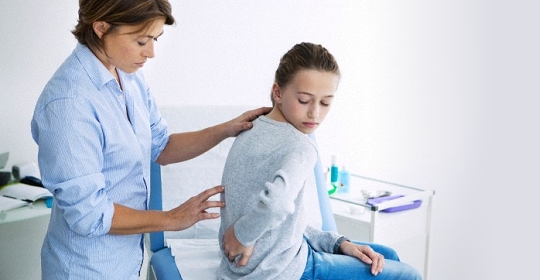
2013-2-15

Spina Bifida Occulta Syndrome is a congenital condition. Studies have shown that the formation of spina bifida is related to the lack of folic acid in the mother before or during pregnancy. If taken 0.4 mg of folic acid a day during pregnancy, the chance of giving birth to a spina bifida baby will be reduced by 75%.
Case Sharing
6-year-old Ms.Liu (female) has had scoliosis since she was 3 years old. When she was 4 years old, she sought medical treatment because of pain in the calf and heel position. After X-ray and examination, she found that the position of the scoliosis and lumbar spine was 30 Degree, upper thoracic spine 15 degrees, lumbar spine and sacrum have recessive spondylolysis, a small depression at the waist, and flat feet.
The 15-year-old Lin (male) had difficulty squatting since he was a child. He would roll back every time he tried, and he also had difficulty doing stretches. Recently, knee pain is suspected to be an old problem caused by sports injuries in school earlier. It was also found that it was difficult to raise his hands. After X-ray examination, it was found that the sacrum had hidden spondylolysis, the spine was slightly curved, and the muscle flexibility was moderately deviated.
16-year-old student Liu (male) once played football with pain in the lower back and upper back, discomfort in the right lower back position, X-ray examination revealed recessive spondylolysis in the lumbar spine and sacrum, abnormal right cuboid joints, short leg, flat feet and his muscle hyper flexibility. The symptoms of the aforementioned three cases of hidden spinal bifida at different ages are roughly the same, including mild to moderate scoliosis, flat feet, inability to squat, abnormal cuboid joints, long and short feet, and deviations in muscle and ligament softness.
Causes
Recessive spinal bifida is a congenital skeletal defect that usually occurs at the position of the first and second sacrum or at the position of the fifth lumbar vertebra. About 5 to 10% of newborn babies worldwide suffer from recessive spinal bifida, but out of one thousand only one patient may have symptoms of low back pain in each case. Because of structural problems, the mechanical structure and support of the spine are relatively poor, so the muscles and ligaments are prone to strain or soreness.
The vertebral arches on both sides of the spine are generally connected, and the central part of the fusion becomes the spinous process, which is the bone that we can touch on our back. The baby is abnormal in the process of embryonic development, which prevents the vertebral arches from fusing together and forms a gap. This gap is called spina bifida (Figure 1). Spina bifida can be a small gap or it can be separated due to a short spinous process (Figure 2).
Some recent studies have shown that the formation of spina bifida is related to the lack of folic acid in the mother before or during pregnancy. If you take 0.4 mg of folic acid a day during pregnancy, the chance of giving birth to a spina bifida baby will be reduced by 75%!

Figure 1

Figure 2
Symptoms of occult spinal bifida
Patients with recessive spinal bifida have this defect at birth. More than 80% of the patients do not have any special symptoms. Common patients are mostly developing teenagers. They usually feel back pain after strenuous exercise and cannot sit for a long time or feel discomfort when standing or moving their lower back. Some patients can’t even squat down since they were young, and they will land backward when they squat, however, if the body is weaker than others, it will also be difficult to do stretches.Other patients will have a small dim at the location of the lumbar spondylolysis (Figure 3). Some more serious cases will have low back pain, weakness, leg pain, weak feet or urinary problems. It was also observed that most patients had flat feet, abnormal cuboid movement, long and short feet, and mild to moderate scoliosis.

Diagnose and Treatment
Generally, the location of the spinal bifida can be clearly seen through X-ray examination. The treatment is all clinically diagnosed and treated with lumbar manipulation. The focus is on alleviating the pain of the patient’s affected area, relaxing the muscles, and strengthening the lower back.

 Book an Appointment
Book an Appointment


